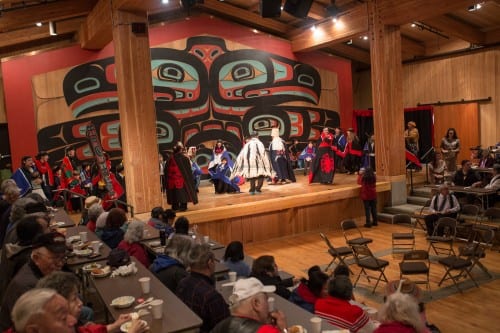
The Sitka School Board will open its meetings with an indigenous land acknowledgement beginning in October.
The board unanimously approved including the acknowledgement at its September 1st meeting. Members said it was an important gesture of respect toward the community’s history and its elders.
The land acknowledgement first came before the Sitka School Board ten months ago, in December of 2020. Although variations of the acknowledgement are becoming more and more common, there was some hesitation.
Mainly, the board wanted to make sure they were getting it right. They handed the issue to the Sitka Tribal Council, who handed it to the Cultural Committee, and that proved to be the right move.
Yeidikook’áa Dionne Brady-Howard said the committee took the job seriously, and came up with three recommendations over the course of several meetings. She believes the effort will pay dividends for both the Tribe and the school board in the future.
“And really trying to strengthen the relationship that the board has as a government to government relationship, and recognizing not only the need to consult with the Tribe in issues surrounding education and Native education, but also just the recognition of our tribal sovereignty, and looking to the Tribe to take the lead on this,” she said. “And so we appreciate it as you come along in your own education, understanding that it definitely is. It can be a very long process, and that we’re doing the best we can to make sure that it is a thorough process.”
The Sitka School Board may not have expected a menu of three possibilities, plus the a la carte ability to craft language of its own. Board member Andrew Hames urged sticking with the language as presented by the Cultural Committee.
“And what my experience has been in, in feedback, when these acknowledgments are suggested, either casually or in a formal meeting setting,” said Hames, “the first thing non-Tribal members say is ‘We like the idea, but we want to make sure we do it correctly, we want to make sure we’re doing it right.’ And so to acknowledge that there’s not necessarily a right or wrong way, but I think it shows good faith to, to take the work that’s been done. And go with it.”
So, it came down to picking one: Option 2 references “Tlingit elders, past, present and future,” and states a commitment to build a “brighter future together.”
This resonated with board member Eric Van Cise.
“Regardless of a person’s culture, the elders are the gatekeepers of a history and knowledge,” said Van Cise. “And so that one stood out for me, but I, I don’t have any objections with number one, either there.”
Option 1 was favored by board president Amy Morrison. It reads, in part “The Sitka School Board acknowledges that our schools are located on the ancestral homelands of the Tlingit people,” and goes on to express gratitude for the care and stewardship of the land.
Morrison thought incorporating the schools into the acknowledgement was important.
“I personally am leaning toward number one,” said Morrison. “I think just because it does specifically acknowledge the school board, or I even think we could maybe change it to the Sitka School District. But in that it specifies our school, and I like that.”
Acknowledgement number 3 was lengthier, and contained a more detailed litany of historic injustices, while concluding on the idea of “weaving a healthier world for future generations.” Some of this language comes from a draft of a land acknowledgement that the Juneau School Board will consider on September 14.
But it didn’t appeal to the Sitka board. Member Andrew Hames also preferred option 1.
“And I, I like the first one again, because, you know, most people speak for most people, but that seems the vibe I get is people just want to show, they want to show respect and gratitude to the indigenous people who have lived here for so long,” said Hames. “And I feel like the first one really captures that.”
Board member Blossom Teal-Olsen didn’t indicate a preference. But whatever the board went with, she wanted it to be honest, and to be the beginning of a meaningful process of communication, rather than a conclusion.
“What will be said, undoubtedly, you know will come from our hearts and it will be sincere but also, just to note that part of partnership is listening,” said Teal-Olsen.
She suggested that the acknowledgement could be revised as needed in the future.
Board member Paul Rioux was absent. The remaining members unanimously adopted option1, which reads, “The Sitka School Board acknowledges that our schools are located on the ancestral homelands of the Tlingit people who have lived in Sheet’ka since time immemorial. We express our deepest respect and gratitude for our indigenous neighbors, the Tlingit for their enduring care and protection of Tlingit Aaní.”
The acknowledgement will join the flag salute preceding all regular meetings of the Sitka School Board beginning in October. Superintendent Frank Hauser recommended including the acknowledgement at other district events, graduation in particular.
“I think this would be an appropriate recognition and acknowledgement to have kind of leading into really our ceremonies that we, you know, come together to celebrate,” said Hauser.
The Sitka School Board now joins boards in Ketchikan, Anchorage, Fairbanks, and the Mat-Su in making an indigenous land acknowledgement at the start of its meetings.






























